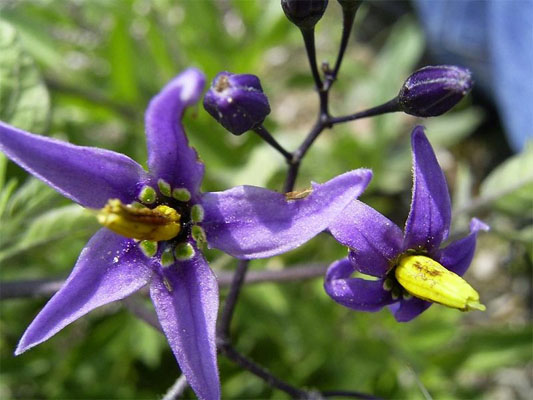 Image of flowers from Wikipedia |
 From Otto Wilhelm Thomé: Flora von Deutschland, Österreich und der Schweiz (1885) - Permission granted to use under GFDL by Kurt Stueber. Source: www.biolib.de |
 Line drawing by M. Szent Ivany, J. Adelaide Bot. Gards 4 (1981) 60, fig. 11. |
 Fruits, flower and potter wasp; image from Wikipedia |
 Habit from Wikipedia |
 Distribution map generated from Australia's Virtual Herbarium. |

Synonymy
*Solanum dulcamara L., Sp. Pl. 1: 185 (1753)
T: Habitat in Europe; LINN 248.7, fide Deb in J. Econ.Taxon. Bot. 1: 46 (1980). A discussion and illustration of the lectotype can be found in Knapp & Jarvis, Bot. J. Linn. Soc. 104: 337, f. 9 (1990). See the Linnaean Plant Name Typification Project
Description
Scrambling perennial shrub, green, slightly to densely pubescent with glandular or simple, non-glandular hairs; prickles absent.
Leaves broadly ovate to ovate-lanceolate; lamina 5.5–8 cm long, 3–4 cm wide, concolorous, entire or upper leaves lobed at base; petiole to 15 mm long.
Inflorescence branched, to 20–flowered; peduncle up to 3 cm long to first fork; pedicels 5–10 mm long. Calyx 2–3 mm long; lobes short. Corolla stellate, 10–12 mm diam., bluish. Anthers 4–4.5 mm long.
Berry ovoid, 5–8 mm diam., bright red. Seeds 2 mm long, pale straw-coloured.
Distribution and ecology
Introduced. Known from only a few collections in Tas.
Common name
Bittersweet, Woody Nightshade
Relationships
A member of subg. Potatoe, species of which are usually creepers or vines with deeply lobed leaves and lacking spines or stellate hairs. American in origin.
Other species of this group in Australia are S. laxum, S. palitans, S. seaforthianum, S. triflorum and S. tuberosum.
Notes
Cultivated in eastern Europe as a possible source of alkaloid and steroid drugs. Information about its long herbal use can be found at http://www.botanical.com/botanical/mgmh/n/nighwo06.html or http://www.botanical-online.com/alcaloidesdulcamaraangles.htm
Known to be toxic to stock in Europe and North America; no known cases of poisoning recorded in Australia.
Selected specimens
Tas.: Hobart, 20 Jan. 1943, W.M. Curtis (HO).
From the web
An image of a flowering and fruiting stem with leaves can be found on the Bean interactive key site at http://delta-intkey.com/solanum/images/sol_dul_215.jpg
Further images and links for this species can be found on the Solanaceae Source site and there are some high resolution images at http://www.plantsystematics.org/.
Further information about this species can be accessed through the Plants Profile site of the US Department of Agriculture.
An image of the flowers and leaves can be seen on the Harmful Plants of the Rutgers University site.
Images of S. dulcamara are hyperlinked at the Digital Flora of Texas site and numerous others are shown at theCalPhotos site of the University of California, Berkeley.
And there are others at http://www.missouriplants.com/Bluealt/Solanum_dulcamara_page.html